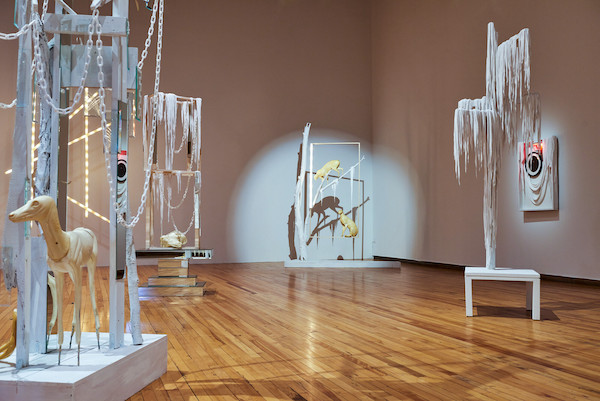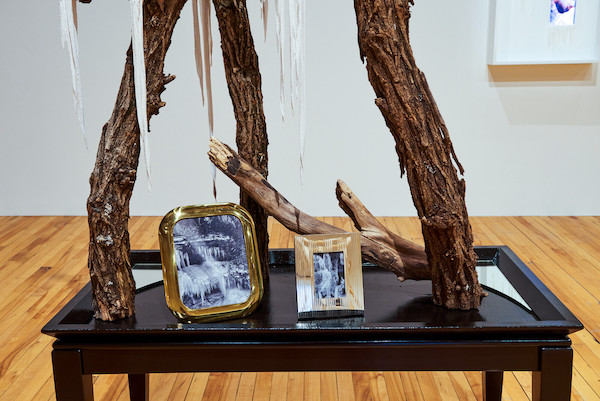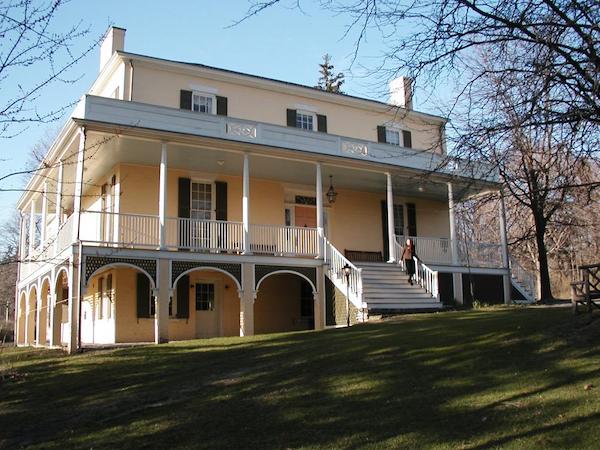Visual Arts Review: “The Ravages of the Ax” — Marc Swanson at MASS MoCA and the Thomas Cole National Historic Site
By Chloe Pingeon
A Memorial to Ice at the Dead Deer Disco does not demand political action from its audience. Instead, it allows viewers to sit within the stark reality of the present, and perhaps find some community within the shared reality that the space creates.
A Memorial to Ice at the Dead Deer Disco, Marc Swanson at MASS MoCA, North Adams, through January 2023. This is the first half of a dual exhibition that continues at the Thomas Cole National Historic Site, at the Main House, Old Studio and Grounds, in Catskill, NY, through November 27.

A view of Marc Swanson’s A Memorial to Ice at the Dead Deer Disco. Photo: MASS MoCA
What hits me most profoundly while drifting through Marc Swanson’s A Memorial to Ice at the Dead Deer Disco is that his work, housed in two of MASS MoCA’s vast upper galleries, projects an unassuming, almost transcendental beauty. Scattered across the first gallrey are large white structures that in some places resemble trees. There are also abstract figurations made of light and mirror. The largest structure stands in the center of the room: an entanglement of white wood and white cloth that serves as an altar, adorned with framed black-and-white photographs of party-goers during the ’80s and of frozen waterfalls. Beneath and surrounding the structure are plastic deer, presented in various icy states. The deer are dead, but somehow the scene is not outwardly violent or gruesome. The world Swanson has created is muted and still, existence suddenly in deep freeze.
For the most part, visitors are left to draw their own conclusions about what they see. There are no title cards on the gallery walls. No audio explains the exhibition’s meaning beyond what can be inferred through the echoing sound of a babbling brook playing above a sculpture of a frosty tree. At first, it is easier to deal with the exhibit in bits and pieces. These are fragments of something that, while unmistakably unified, is not necessarily ordered. Still, Swanson offers a brief guide in a statement on the wall. The work reflects the sense of freedom he found in nightclubs and in nature. The “memorial” celebrates the beauty, the community, and the freedom that nightclubs gave him when he was an 18-year-old from New Hampshire. But the show also mourns how these spaces became sites of loss and danger during the AIDS crisis. Swanson also discovered this freedom in the woods of the Catskills. But, while these woods are around today, he anticipates that in the future they will be ravaged by climate change.
At MASS Moca, the woods and the nightclubs are in dialogue: a disembodied head of a dead deer sits underneath a structure made up of light and glimmering mirrors. There’s an outline of a frozen tree under a disco ball. Nature is envisioned as calm and cold. No green is to be found; neither is there music or people to accompany the dazzling lights. This is a stripped down portrait of humanity, with suggestions of an intrinsic fragility. The party is over, now preserved via a memorial. The same could be said about the natural world. Swanson mourns the lost spaces of freedom, the liberation he discovered in disco and the woods, but he also pays fierce homage to the beauty of those spaces, despite (or because of) their impermanence.

Another view of a piece in Marc Swanson’s A Memorial to Ice at the Dead Deer Disco. Photo: MASS MoCA.
Despite the theme of extinction, there is no placard that asks that we use sustainable materials or links that direct visitors towards donation resources. On the phone, Swanson tells me that he believes that people who were (and are) deeply affected by the AIDS crisis can help us understand the challenging nature of the climate crisis. It is hard to conceive of catastrophe — unless you are confronted with it. If A Memorial to Ice at the Dead Deer Disco is about the need to take political action, its strategy is to present the stark reality of the present. First, face unpleasant facts — then imagine a solution. Swanson’s approach here is philosophical rather than pragmatic.
The second gallery of the exhibition is dark. Organized around a foreboding permanent bronze installation by Joseph Beuys, the light here mimics dusk. Hanging from the ceiling in the far corner is a column of glimmering deer antlers etched in rhinestone.They rotate in circles of light, projecting colorful shadows on the white walls. A museum staff member tells me this installation is a vision of time beyond climate change. Notably, there is no human presence here, or anywhere else. The rhinestone deer, according to the staff member, symbolize hope for the future. But to me this seems to be a post-tragedy image. There is no hope disaster will be averted. Most contemporary art that explores the climate crisis understandably aims to shout warnings. There is the assumption, at least the slight possibility, that with effective action nature may be preserved. Swanson tells us here that it is already too late. We are past the point of no return.
The message is dire, but the work is not angry. The rhinestone deer, albeit frozen, glow as they spin. Some may see this as nihilism, But it is simply Swanson’s way of acknowledging that destruction inevitably creates beauty. The work feels strangely peaceful, as if there is solace — for the artist, for us — in imagining the worst.

Thomas Cole National Historical Site
The drive from MASS MoCA to the Thomas Cole National Historic Site winds right through the landscape Swanson memorializes in his work. The mountains are green and misty. Fog shrouds the horizon, but the smoky gauze only makes the emerald leaves of the Catskills all the more vivid. It’s pouring rain when I arrive. For the Thomas Cole house, Swanson has created a site specific exhibition. Cole, an early member of the Hudson River School of painters, was deeply moved by the beauty of the Catskills. And he was deeply disturbed by the deforestation and logging that beset the area almost 200 years ago. Cole’s paintings revel in the landscape’s lush yet mild peace. The windows of his home look out over the same green grandeur, and it is this aesthetic calm that Swanson grew to love when he moved to the Catskills. It wasn’t until almost a year after he relocated that Swanson learned that the creek in his backyard is the same one Cole returned to time after time in his painting.
Swanson’s show pivots on a bittersweet conversation with the 19th-century artist. If Cole could see the Catskills today, he would be overjoyed. The trees have grown back; the mountains are alive and lush. But, if he were here today, he would be forced to confront the reality of climate change, a far larger, and more existential, threat to the woods than the systematic plunder of loggers.
Swanson’s gilded deer and white shadowy structures sit in Thomas Cole’s home, but the pieces feel starker in this location. The limber frames of the animals and the glowing towers of the artist’s trees evoke a sense of the present in the past. The contrast should be unnatural: a plastic deer stares into the heart of a 200-year-old oil landscape. There is a predictable sense of uneasiness: Swanson’s pieces inflict a mournful awareness of contemporary alarm. But, at least for me, the contrast triggers a conversation between the centuries. Cole’s mountains were destroyed and then regrown. Swanson is reworking the same landscape, inspired by the same creek, now endangered by a new human threat. Will the cycle repeat itself? Swanson seems to think that’s the nature of things; the thing to do is to memorialize the present, to chill time.
Chloe Pingeon recently graduated from Boston College, where she studied film and journalism. She has written regularly for the features and arts section of Boston College’s independent student newspaper, the Heights, and has also written for the culture section of Lithium Magazine. She is currently a creative development intern at Foundation Films.
